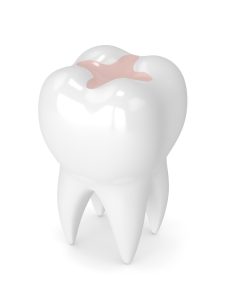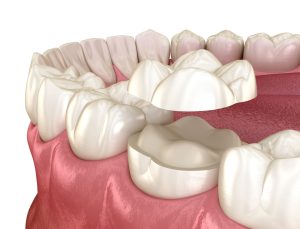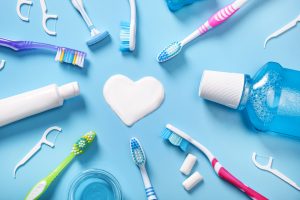What are Dental Inlays and Onlays?
Dental inlays and onlays also called are types of dental restorations used to repair and strengthen damaged or decayed teeth. Dental inlays or indirect fillings are custom-made fillings that fit into the chewing surface of a tooth. They’re typically used when a tooth has a small to moderate amount of decay or damage.
Dental onlays or partial crowns are similar to inlays but cover a larger portion of the tooth. They extend onto the chewing surface and may also cover one or more cusps (points) of the tooth. Onlays are used when the damage or decay is more extensive than a filling could fix, but not so damaged that a crown is required, providing a more substantial restoration.
Benefits of Dental Inlays and Onlays
- Conservative Approach: Inlays and onlays are considered more conservative than dental crowns. They allow the preservation of more natural tooth structure, as only the damaged or decayed portion is removed.
- Strength and Durability: These restorations are crafted from strong and durable materials such as porcelain, composite resin, or gold. This ensures that they can withstand the forces of biting and chewing, providing long-term strength to the tooth.
- Natural Appearance: The materials in inlays and onlays can be matched to the color of your natural teeth, providing a seamless appearance. This makes them aesthetically pleasing and minimally noticeable.
- Custom Fit: Inlays and onlays are custom-made to fit precisely into the prepared tooth, ensuring a snug and accurate fit. This customization contributes to their effectiveness in restoring the tooth’s function.
- Longevity: With proper care and maintenance, dental inlays and onlays can have a long lifespan. Regular oral hygiene practices and dental check-ups contribute to their durability over time.
- Minimized Sensitivity: Inlays and onlays can help reduce tooth sensitivity by sealing and protecting the exposed dentin or nerve of a damaged tooth.
- Easy Maintenance: Maintaining good oral hygiene practices, such as regular brushing, flossing, and dental check-ups, can help ensure the longevity and effectiveness of inlays and onlays.
Who Qualifies for Dental Inlays and Onlays?
Here are some situations where dental inlays and onlays may be recommended:
- Moderate Decay: When a tooth has decay that is too extensive for a simple filling but not severe enough to warrant a dental crown, an inlay or onlay may be a suitable option.
- Fractured Teeth: If a tooth has a fracture or a large, old filling that needs replacement, an inlay or onlay can be used to restore the tooth’s structure.
- Preservation of Tooth Structure: Patients who want to preserve as much natural tooth structure as possible may be good candidates for inlays and onlays, as they require less healthy tooth removal compared to dental crowns.
The Dental Inlays and Onlays Process
Consultation
During the initial consultation, Dr. Nishime will examine your teeth and assess the extent of damage or decay. X-rays may be taken to get a detailed view of the affected tooth. If it’s determined that an inlay or onlay is a suitable treatment option, our dentist will discuss the process with you, addressing any concerns or questions you may have.
Design
Once the decision to proceed with an inlay or onlay is made, the next step involves designing the restoration. Impressions of your teeth may be taken, either digitally or with traditional molds. These impressions serve as a model for creating a custom-fit inlay or onlay. Dr. Nishime will also choose the appropriate material, such as porcelain or composite resin, to match the color and appearance of your natural teeth.
Preparation
Before the final restoration can be placed, the damaged or decayed portion of the tooth needs to be prepared. Dr. Nishime will remove the affected area, shaping the tooth to accommodate the inlay or onlay. Once the preparation is complete, our dentist may place a temporary restoration to protect the tooth while the final restoration is being crafted.
Installation
After the inlay or onlay is custom-made in a dental laboratory, you’ll return to Advanced Restorative Dentistry for the final installation. The temporary restoration will be removed, and Dr. Nishime will check the fit and color match of the new restoration. He’ll make any necessary adjustments before the inlay or onlay is permanently bonded to the tooth using dental cement.
Dr. Nishime will ensure that the restoration is secure, properly aligned with your bite, and seamlessly blends with your natural teeth. After installation, post-operative care instructions will be provided to ensure the longevity and success of the restoration.
Aftercare for Dental Inlays and Onlays 
- Oral Hygiene: Maintain a thorough oral hygiene routine by brushing your teeth at least twice a day and flossing once a day. Use fluoride toothpaste and a soft-bristled toothbrush to keep the inlay or onlay, as well as surrounding teeth and gums, clean.
- Regular Dental Check-ups: Schedule regular dental check-ups to allow our dentist to monitor the condition of the inlay or onlay and address any potential issues promptly. Professional cleanings will also help keep your oral health in top shape.
- Avoid Chewing Hard Objects: To prevent damage to the restoration, avoid chewing on hard objects such as ice, pens, or hard candies. Also, refrain from using your teeth to open packages or bottles.
- Limit Staining Substances: If the inlay or onlay is made of tooth-colored material, be mindful of consuming staining substances like coffee, tea, red wine, and tobacco. While these restorations are stain-resistant, minimizing exposure to such substances can help maintain their appearance.
- Watch for Changes: Pay attention to any changes in your bite, discomfort, or sensitivity. If you experience unusual symptoms or notice any issues with the inlay or onlay, contact your dentist promptly for an evaluation.
- Night Guards for Bruxism: If you have a habit of grinding or clenching your teeth (bruxism), consider using a night guard. Bruxism can put additional stress on dental restorations, and a night guard can help protect them while you sleep.
- Healthy Lifestyle Choices: Maintain a healthy lifestyle, as overall health can impact oral health. Stay hydrated, eat a balanced diet, and avoid excessive consumption of sugary foods and drinks.
Frequently Asked Questions
Coverage varies among dental insurance plans. In many cases, dental insurance may cover a portion of the cost, particularly if the restorations are deemed necessary for oral health. Check with your insurance provider for specific details on coverage.
The process is generally not painful. Local anesthesia is used during the preparation phase, ensuring you’re comfortable. After the procedure, some temporary sensitivity may occur but can be managed with over-the-counter pain relievers.
Yes, if an inlay or onlay becomes damaged or worn over time, it can be replaced. Regular dental check-ups help identify any issues early, allowing for timely replacement if necessary.
The decision is based on the extent of damage or decay. Inlays and onlays are often recommended when a tooth has more significant damage than what a standard filling can effectively address but not enough that it warrants a full crown. Your dentist will assess the situation and recommend the most suitable option for your case.
Dental Inlays and Onlays Can Transform Your Smile — Call & Learn More!
If you’re looking to repair a damaged smile without opting for a traditional crown, dental inlays and onlays at Advanced Restorative Dentistry of Honolulu could be the perfect solution. Dr. Michael Nishime specializes in providing minimally invasive restorations that preserve natural tooth structure while delivering a beautiful and durable result.
Take the first step towards a better smile by calling us at (808) 732-0291 or clicking the button below to schedule your consultation. Your journey to a healthier, more confident smile starts here!



